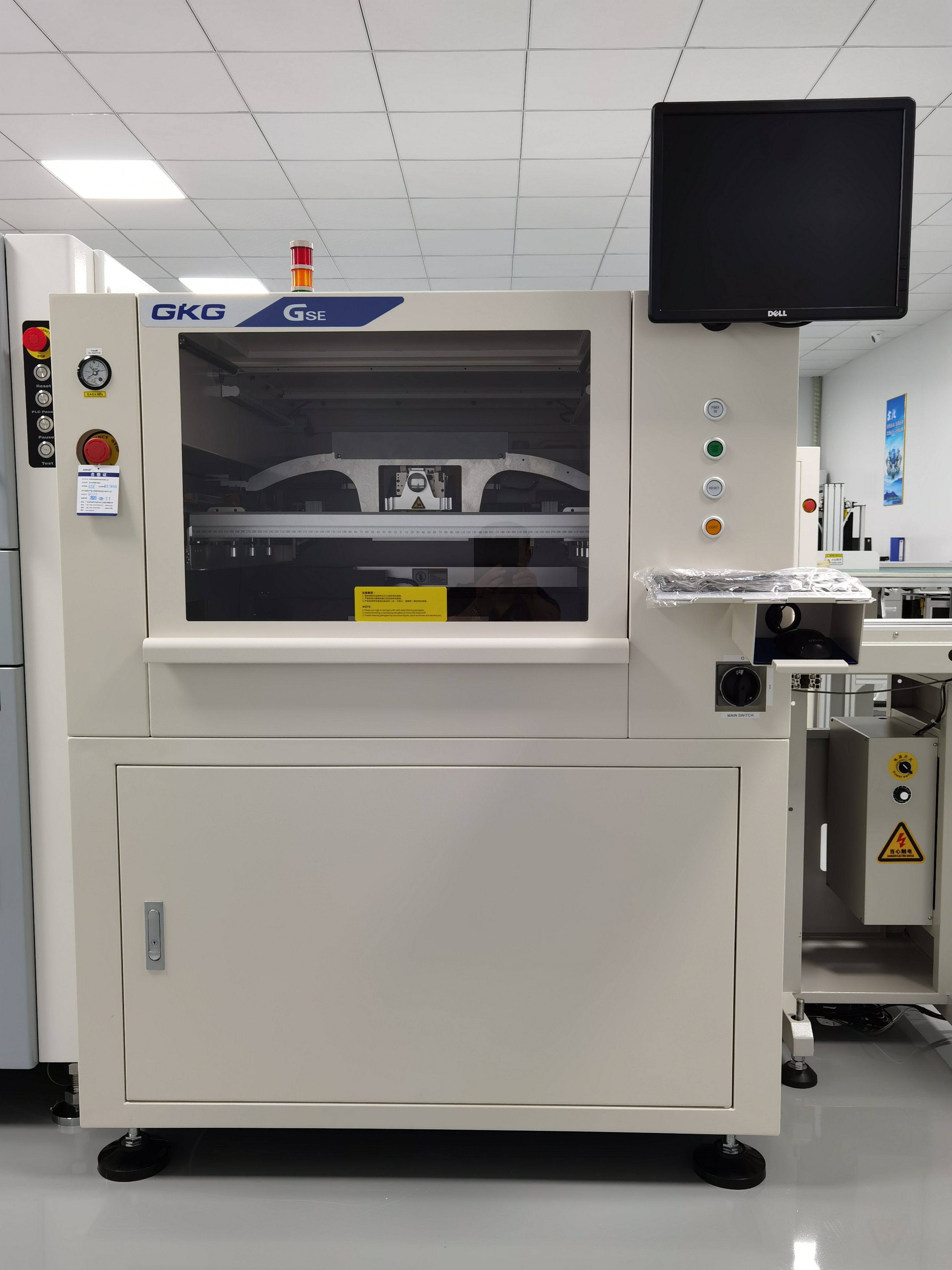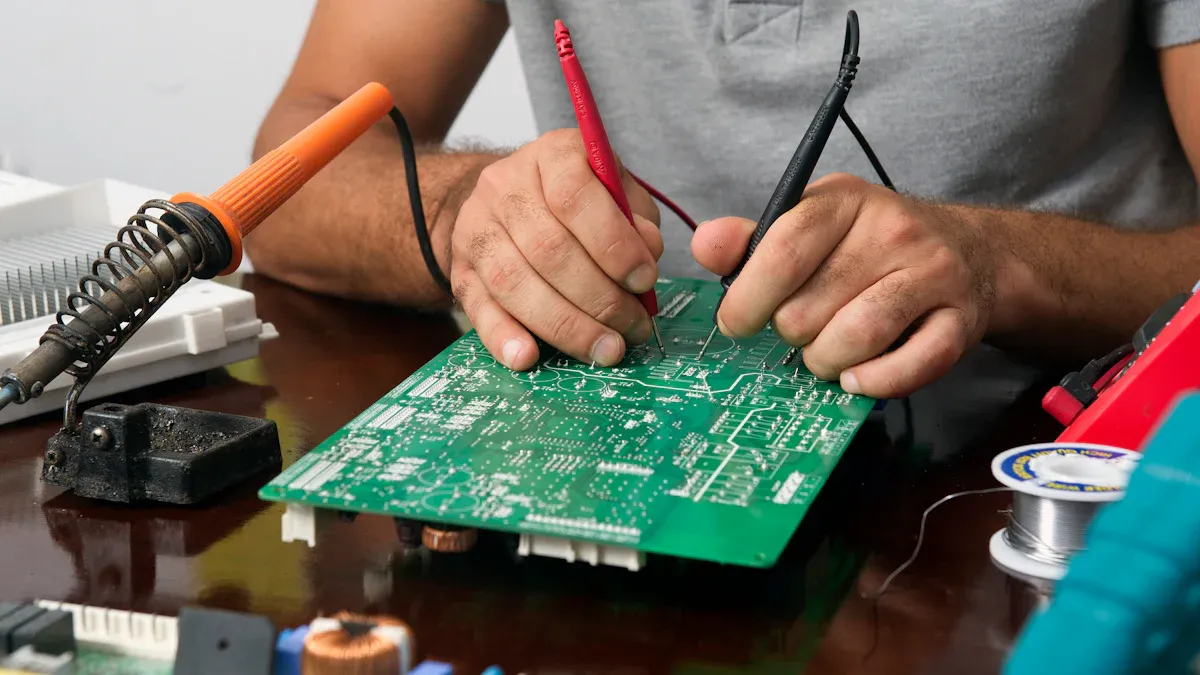Equipment, tools and process materials for smt wave soldering
SMT wave soldering uses special machines, exact tools, and good process materials. Important things that affect quality and speed are:
Real-time SPC checks heat levels, finds changes, and helps stop mistakes.
Equipment data and watching the environment help keep production steady.
Solder Type | Melting Point (°C) | Peak Reflow Temp (°C) |
|---|---|---|
Leaded (Sn63Pb37) | ~183 | N/A |
Lead-Free (Sn99.3Cu0.7) | 245–260 |
Switching to lead-free soldering needs higher heat and careful control in smt wave soldering.
Key Takeaways
Modern wave soldering machines and accurate tools help make more good boards quickly. They also save energy and cut down on mistakes.
Picking the right solder alloys and flux, and using them with care, makes strong and dependable solder joints. This also helps lower the number of defects.
Watching heat, solder wave, and flux closely during the process stops common problems. It also keeps the quality the same each time.
SMT Wave Soldering Equipment and Tools

Wave Soldering Machines
Wave soldering machines are very important for smt wave soldering. They work with both through-hole and mixed-technology PCB assembly. Newer machines keep the temperature steady, so parts do not get too hot. This helps protect the parts from heat damage. Operators can control the process better and make fewer mistakes. This means more good boards are made. Modern machines also use less energy, sometimes saving up to 20% compared to old ones. They can do both leaded and lead-free soldering, so they fit many jobs.
Tip: New wave soldering machines can help save money on electricity and make more boards faster. This makes them a smart choice for big factories.
Production lines with these machines can finish more boards faster than reflow soldering, especially with big batches. These machines have safety features and can be taken apart easily for fixing. This helps them meet new rules.
Machine Modules: Preheating, Fluxing, Solder Wave, Cooling
Each smt wave soldering machine has several main parts. These parts work together to make strong solder joints and keep the process steady.
Module | Key Features | Performance Impact |
|---|---|---|
Preheating | Adjustable bottom preheating, large preheating area, high-temp insulation, quality motors | Gives even heat to PCBs, lowers stress, and makes soldering better |
Fluxing | High-precision valves, accurate XY nozzle positioning, stable pressure tanks, corrosion resistance | Puts flux on evenly, which lowers mistakes and makes joints stronger |
Solder Wave | Titanium solder pot, rapid heating, stable wave generation, N2 heating, real-time monitoring | Keeps the solder wave steady and hot, making joints more reliable |
Cooling | Integrated system controls, process monitoring | Helps keep the process steady and stops problems during cooling |
Detection & Control | Laser sensors, jam detection, top-brand components | Watches the process closely and helps keep it running well |
Operators can change each part to fit different PCB designs. For example, careful fluxing helps stop solder bridges. A steady solder wave makes sure each joint gets enough solder. Watching the process in real time and using software helps keep things steady.
Pallets and Fixtures
Pallets and fixtures are very important in smt wave soldering. They hold PCBs in place and keep solder away from some areas. The kind of pallet and how thick it is changes how heat moves during soldering. Thick or very conductive pallets can take in too much heat. This can cause cold solder joints. Operators may need to turn up the solder pot heat or warm up the pallet first to get good soldering.
Special rotary wave fixtures let you change the board angle. This helps stop bridging and skipping, especially on tricky boards with connectors close together. Using these fixtures and making the process better can cut down on touch-ups by up to 96%.
Things to think about for pallets and fixtures:
What the pallet is made of and how thick it is
Enough space for solder to touch the right spots
Good flux coverage
Checking heat with thermal profiling
Note: Check fixtures often and change settings if needed to keep getting good solder joints.
Supporting Tools
Supporting tools help make smt wave soldering more exact and faster. Conveyors move PCBs smoothly through each step and keep them in the right place. Nozzles, especially ones with piezoelectric ceramic jet valves, help control how flux is sprayed. Operators can change how long, how fast, what angle, and how much flux is sprayed for each board.
Good things about advanced supporting tools:
Computers can set the path for soldering speed and wave height
Nozzles clean themselves and keep flux pressure steady
No need for extra fixtures in places that do not need solder, which helps with accuracy
Strong conveyors and good nozzles help lower mistakes and keep the quality the same. These tools, along with real-time checks, help make lots of boards and keep results steady.
Process Materials and Quality Control

Solder Alloys: Leaded and Lead-Free
Solder alloys are very important in smt wave soldering. Picking leaded or lead-free alloys changes how hot things get and how safe the process is for people and the planet. Leaded solders like Sn63Pb37 melt at lower heat and work well. But many rules now say factories must use lead-free alloys. Lead-free types, such as Sn99.3Cu0.7 or Sn-9Zn-2.5Bi-1.5In, need more heat and careful watching.
Adding things like Co, Bi, Ni, and Cu to lead-free SnAgCu solders helps them last longer when electricity flows through them. This makes solder joints stronger under stress. For example, putting in 2% Cu slows down bad growth inside the solder and makes it more reliable. Scientists learned that preheating matters most for stopping mistakes. When they used a preheat of 170°C, a speed of 1050 mm/min, a soldering heat of 250°C, and HF28 flux, they saw the fewest problems. The Sn-9Zn-2.5Bi-1.5In alloy spread better and did not rust as much, especially with nitrogen. X-ray and metal tests showed this alloy made even solder joints with fewer mistakes.
Data shows lead-free solders use more energy and stuff to make than tin-lead solders. Lead-free types lower lead risks but can use more power and make more pollution. Both kinds have good and bad sides. Leaded solders can hurt workers more, but lead-free ones can harm the earth in other ways. Factories must think about all this when picking the best alloy for smt wave soldering.
Flux Types and Application
Flux is needed in smt wave soldering because it cleans metal and helps solder stick. The kind of flux and how you use it can change how strong the joints are. Picking the right flux makes joints strong and stops rust or electric trouble.
Using no-clean flux means you must change heat settings and sometimes use nitrogen to get good results.
Spraying flux and watching how much you use helps cut down on leftover stuff and makes things work better.
Checking flux and solder mix keeps joints the same every time.
High-reliability PCBs need strict steps and cleaning to stop dirt.
Machines that move PCBs and parts help keep things clean.
The right flux matches the metal and heat, which is key for cleaning and making strong joints. Too much or too little flux can cause weak joints, holes, or rust. Good ways to put on flux, like spray nozzles or pens, help lower leftovers and make solder spread better.
Tests show flux strength changes how well soldering works, especially with bridging. Not enough flux makes solder not stick and causes bridges. Even spraying and the right preheat are needed for good results. Preheating helps the flux dry at the right time, keeps it thick enough, and stops the solder wave from washing it away too soon. Good flux use and control lower mistakes and make better solder joints in smt wave soldering.
Cleaning Agents
Cleaning agents take off flux and dirt from PCBs after soldering. They are extra important for electronics that must work well. Studies show cleaners like isopropyl alcohol and special liquids help solder stick by removing dirt. Tests like the Wetting Balance Test and Area of Spread show that cleaning before soldering helps solder spread and stick better.
Scientists also found that different soldering ways leave different amounts of dirt. Wave soldering leaves less dirt than selective soldering. But if you do not clean well, problems like blisters can happen, especially when it is wet. Cleaning right lowers these risks and makes the product work better.
Process Control
Process control keeps smt wave soldering quality the same. Workers watch and change things like solder wave height, conveyor speed, solder heat, preheat, and flux action. These things change how good the solder joints are.
Checking heat and cooling stops the PCB from bending or breaking parts.
Statistical Process Control (SPC) helps keep things steady and good.
Special tools and software check heat, wave height, and contact time for better control.
How long the PCB stays in the solder wave is very important. Watching things in real time lets workers fix problems fast, keeping quality high and mistakes low. Closed-loop systems, like ExactaWaveTM, keep wave height just right for steady results. Lead-free soldering needs even tighter control because it melts at higher heat and does not spread as well. Stopping rust and keeping machines steady also help lower mistakes.
Common Defects and Prevention
Common problems in smt wave soldering are solder bridges, skips, holes, and cold joints. Stopping these starts with good PCB design, process control, and taking care of machines.
Adding a rough 'chip' wave before the main solder wave helps stop skips from shadows and trapped flux.
Spray nozzles control how much flux goes on and where, better than foam fluxers.
Using nitrogen instead of air cuts down on rust and makes joints better.
Solder mask type, like matte or gloss, can change how often bridges happen.
Good PCB design, with the right hole sizes and part direction, lowers bridges and holes.
Keeping solder wave height and heat steady makes joints even and flux work right.
Controlling flux and preheat stops holes, cold joints, and rust.
Watching things in real time and using sensors for solder wave height and heat lets workers fix things fast.
Checking and fixing machines often stops machine problems.
Teams working together on design, process, and machines help keep getting better and stop mistakes.
Tip: Keeping the process steady, picking the right materials, and checking machines often are the keys to making strong, reliable smt wave soldering.
Picking the best equipment, tools, and process materials helps make smt wave soldering strong. Teams can make better boards by following process control steps and looking for mistakes. Factories need to use new technology and follow lead-free rules. Operators who learn fast get more good boards and have fewer issues.
FAQ
What is the main difference between leaded and lead-free solder in SMT wave soldering?
Leaded solder melts when it gets less hot. Lead-free solder needs higher heat and more careful watching. Factories pick lead-free solder to follow safety laws.
How does flux improve soldering quality?
Flux cleans the metal so solder can stick better. It stops the metal from rusting and makes joints stronger. Operators pick the best flux for each job.
Why do operators use pallets and fixtures during wave soldering?
Pallets and fixtures keep PCBs in one place. They block solder from going where it should not. These tools help make more good boards and fewer mistakes.
See Also
Comprehensive Instructions For Wave Soldering In Surface Mount Technology
Essential Criteria For Wave Soldering During DIP Assembly Operations
Key Process Standards For Reflow Soldering In SMT Manufacturing
Electrostatic Discharge Protection Design For SMT Assembly Facilities
Common Techniques And Workflow In Surface Mount Technology Assembly
